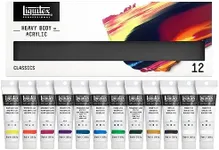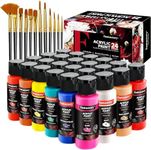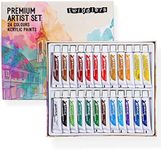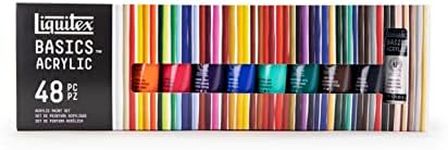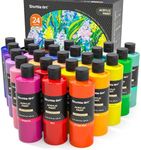Buying Guide for the Best Acrylic Paints
Choosing the right acrylic paints can significantly impact your artwork. Acrylic paints are versatile, fast-drying, and can be used on various surfaces. When selecting acrylic paints, consider factors such as color quality, consistency, drying time, and the type of finish you desire. Understanding these key specifications will help you make an informed decision and ensure that your creative needs are met.Color QualityColor quality refers to the vibrancy and richness of the paint. High-quality acrylic paints have a higher pigment concentration, resulting in more vivid and intense colors. This is important for achieving the desired effect in your artwork. If you are a beginner or working on practice pieces, student-grade paints with lower pigment concentration might be sufficient. For professional work, artist-grade paints with higher pigment concentration are recommended.
ConsistencyConsistency of acrylic paint can vary from thick and buttery to thin and fluid. Thick paints are ideal for impasto techniques and creating texture, while thinner paints are better for washes and detailed work. Consider your painting style and techniques when choosing the consistency. If you enjoy creating textured, bold strokes, opt for thicker paints. If you prefer smooth, detailed work, go for thinner paints.
Drying TimeAcrylic paints are known for their fast drying time, but this can vary between brands and formulations. Fast-drying paints allow for quicker layering and are ideal for artists who work quickly. Slower-drying paints provide more time for blending and mixing colors on the canvas. Think about your workflow and how much time you need to manipulate the paint before it dries. If you need more time for blending, choose slower-drying paints.
FinishAcrylic paints can have different finishes, such as matte, satin, or glossy. The finish affects the final appearance of your artwork. Matte finishes are non-reflective and give a more subdued look, while glossy finishes are shiny and vibrant. Satin finishes offer a balance between matte and glossy. Consider the effect you want to achieve in your artwork. If you want a bright, reflective surface, choose glossy paints. For a more muted look, opt for matte paints.
OpacityOpacity refers to how transparent or opaque the paint is. Opaque paints cover underlying layers completely, while transparent paints allow some of the underlying layers to show through. This is important for layering techniques and achieving depth in your artwork. If you want solid coverage, choose opaque paints. If you want to build up layers and create depth, transparent paints are a better choice.





